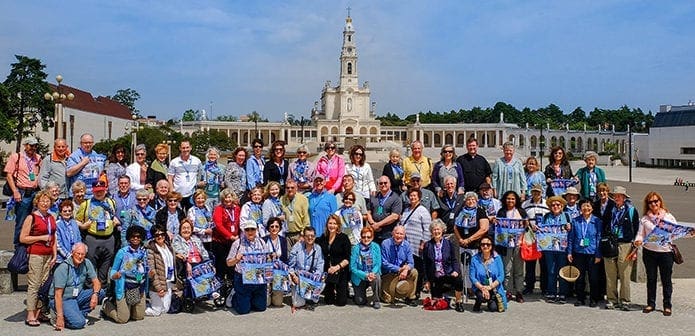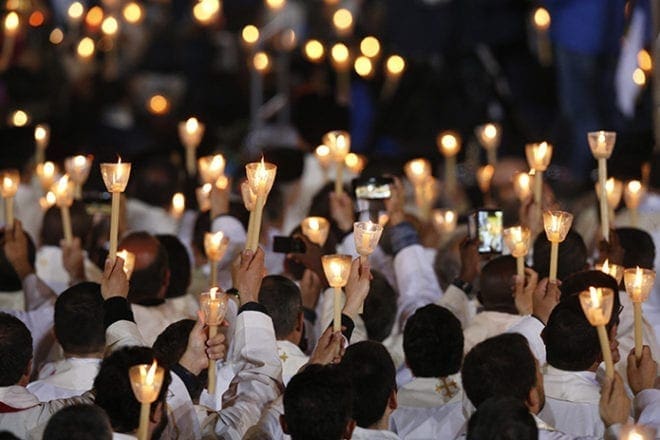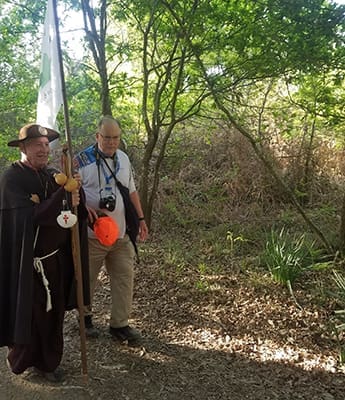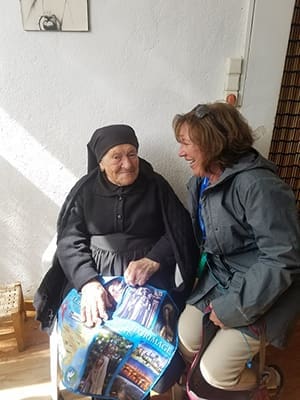
Fatima
Pilgrims immersed in prayers at Marian shrines of Fatima, Lourdes
By GRETCHEN KEISER, Staff Writer | Published June 23, 2017
FATIMA, Portugal—In the warm darkness, thousands of faces were illuminated by candlelight. People bunched together around a small chapel where the rosary was being led. Every five Hail Marys began in a different language. The fragrance of wax filled the air. The huge open square twinkled here and there where people sat holding candles.
At times, a penitential pilgrim passed through on his knees, inching toward the chapel, undeterred by the crowd.

People raise candles as Pope Francis leads the blessing of candles at the Shrine of Our Lady of Fatima in Portugal, May 12. The pope was making a two-day visit to Fatima to commemorate the 100th anniversary of the Marian apparitions and to canonize two of the young seers. CNS photo/Paul Haring
While the languages were foreign, the cadence of the prayer was familiar. It didn’t take long to begin to respond, “Holy Mary, Mother of God, pray for us sinners, now and at the hour of our death. Amen.”
The night of April 19, a group of pilgrims from Atlanta, who had been in transit to Fatima for 20 hours, were suddenly melded into praying the nightly rosary with people from all over the world.
They were standing at the site where 100 years earlier the Mother of God appeared to three village children.
When five Hail Marys were prayed in English at the Chapel of the Apparitions, they were led by Father Tim Hepburn, who, with Msgr. Dan Stack, accompanied the Georgia group.
Following the rosary, the large statue of Our Lady of Fatima was borne around the perimeter of the plaza while the sea of people gradually flowed into a broad procession behind it, holding candles aloft and singing, “Ave, Ave, Ave, Maria.”
Stepping into that procession was a moment 36 years in the making for John and Arlene Gannon. Their lives changed at that time through a book on the message of Fatima.
“In a nutshell, John read a book called ‘Fatima in Lucia’s Own Words,’” Arlene Gannon said later. “A gal gave it to me when we lived in Ohio. I had no intention of reading the book.”
“He picked up the book, read it over the weekend, and our whole lives changed,” she continued. “He knew immediately the things we weren’t doing right. … We tried to turn our lives around.”
Fatima influences world history
The essential message of Mary given to the children, 10, 9 and 7 years old, was to pray the rosary every day for peace in the world, to make reparation for sin, and to pray for the conversion of sinners. At the time World War I was underway.
She also told them of the possibility of an even worse war and great suffering by the church, the pope, and many nations that could be averted through prayer. Still more the message spoke of prayer for the conversion of Russia and consecration to the Immaculate Heart of Mary.

The children who saw the visions at Fatima were (l-r): Lucia dos Santos and St. Francisco and St. Jacinta Marto. The Martos, who died in 1919 and 1920 during the Spanish flu pandemic, were declared saints this year on May 13. The canonization cause of Sister Lucia, a Carmelite nun who died in 2005, is now being considered.
The tiny chapel was built immediately after the series of apparitions occurred from May 13 through October 13, 1917. It remains. In addition, two large churches now anchor each end of the plaza, serving thousands who come to pray in Fatima.
A section of the Berlin Wall is on display at the shrine, a concrete slab torn down after the collapse of communism in Eastern Europe, which its donors attribute to the help of Our Lady of Fatima.
A bullet fragment is in the crown of her statue, given by St. John Paul II, who said Our Lady of Fatima saved his life when he was nearly assassinated in St. Peter’s Square on May 13, 1981, her feast day.
Arlene Gannon tries to make better known the requests given to the Fatima visionaries, Lucia dos Santos and Francisco and Jacinta Marto. The Martos, who died in 1919 and 1920 during the Spanish flu pandemic, were declared saints this year on May 13. Sister Lucia, who became a cloistered Carmelite nun, died in 2005. Her cause for sainthood is underway. All three are interred in the Fatima basilica.
In the nearby village where the children grew up, the Georgia pilgrims visited their homes and the fragrant hills planted with olive trees where statues mark the appearances of an angel and the Blessed Mother to the seers.
Gannon gave a program on Fatima May 13 at All Saints Church in Dunwoody, the couple’s parish, to make the requests of Mary known.
“Do I feel the urgency for people personally, yes, I do,” she said. “We see what is happening in marriages, we see what is happening in morality, we see the numbers in our families who are no longer going to church—yes, I do feel an urgency.”
“The Blessed Mother tells Lucia in every one of the apparitions to pray the rosary every day,” Gannon said.
Mary also told the young visionary, Francisco, he would need to pray many rosaries in order to reach heaven.
Arlene said she is grateful to have prayed with thousands in Fatima April 19 and 20.
“When we were able to go over there, 36 years later, it was just perfect. … When we prayed in that candlelight procession those two nights … what a gift. … It was the 100th anniversary. It was God’s perfect timing.”
“We were so touched because we could finally go and thank the Blessed Mother for the grace she gave us to change our sinful ways.”
Region dedicated to St. James
Sixty-three people went on the April 18-28 pilgrimage hosted by the Georgia Bulletin. In addition to the Marian shrines in Fatima, Portugal, and in Lourdes, France, pilgrims visited Spanish cities of Santiago de Compostela, Zaragoza and Loiola, conversion site of St. Ignatius.
Terri Buckley went with her husband, Dan, a deacon. They belong to St. Matthew Church, Winder. Terri said she had never been on a pilgrimage before and went with no expectations. She went because of the 100th anniversary of the apparitions of Our Lady of Fatima.
She came home with a stronger faith. “I know Jesus. He really did die for us. He really did rise. But going where the disciples were, where Our Lady was—it did so much for my faith.”

Msgr. Dan Stack, center, celebrates Mass on Divine Mercy Sunday April 23, assisted by Father Tim Hepburn, right, who concelebrated the Mass, and Deacon Dan Buckley, left, of St. Matthew Church, Winder. The Mass for the Georgia pilgrims was celebrated in a small chapel on the grounds of their hotel in Santiago de Compostela.
Returning home she knows that her beliefs face the skepticism that is all around her, but she said she has a new strength. “That 10 days, it just did so much to strengthen my faith. I know I am not going to see the results yet. It will come in the future.”
“I learned so much of the history of every shrine. I really enjoyed being in the place where Mary had appeared, even though it was a long time ago, and learning about Fatima and the children. Our tour guides were amazing.”
Taking part in the immersion in the healing baths of Lourdes, she said, “was truly a spiritual experience. It was something. It was almost like Our Lady touched me physically. … It is an indescribable experience.”
She was impacted by the region’s religious history associated with St. James, particularly the belief that Mary miraculously came to the apostle in what is now Spain while he was struggling to evangelize in the first century after Jesus’ resurrection. At that time Mary was still alive in the Holy Land so this is not considered an apparition but a bilocation. Mary is credited with giving St. James the encouragement to persevere and asking him to build a chapel around a small stone pillar she gave him. The site is now the Basilica of Our Lady of the Pillar in Zaragoza, co-patron with St. James of Spain.
“That gave me such encouragement to know these struggles had been going on since the beginning of time and how she intervened to give him the courage to go on … just like a mother,” Buckley said.
She, along with about 40 in the group, walked six miles on the Camino, the pilgrimage way that ends at the Cathedral of St. James in the city of Santiago de Compostela, where the remains of the apostle are interred.
Walking as pilgrims
Portuguese guide Pedro Pais said ordinary people in Portugal and surrounding countries regularly walk on a pilgrimage to Fatima to ask for a prayer need or thank God for answered prayers. He has done it three times himself. Portugal, which has a population of about 10.2 million people, is over 90 percent Roman Catholic.

Msgr. Dan Stack, right, walks with a friendly pilgrim in traditional garb on the Camino, the well-traveled path that ends at the Cathedral of St. James in the city of Santiago de Compostela, Spain. Most of the pilgrimage group walked six miles on the Camino.
North of Portugal, in the northwestern region of Spain, the Camino is a network of ancient pilgrimage paths that originate in Portugal, France, Spain and other countries, but all lead to the burial place of St. James. The scallop shell is the symbol of the Camino, showing the many lines converging in one place.
Pilgrimages on the Camino began in the ninth century, just after the discovery of the burial site of St. James, and were common for 600 years. A modern wave of pilgrims on the Camino began in the 20th century, a movement that continues.
These expressions of pilgrimage, both ancient and contemporary, reflect a deeper faith reality.
In the Old and New Testament, from Abraham to Moses to St. Joseph, people of faith were guided by God from one place to another and led to where God revealed himself to them.
According to the Catechism of the Catholic Church, “Pilgrimages evoke our earthly journey toward heaven and are traditionally very special occasions for renewal in prayer. For pilgrims seeking living water, shrines are special places for living the forms of Christian prayer ‘in Church.’”
More rosaries to pray
Deacon Evelio Garcia-Carreras, of St. Stephen the Martyr Church, Lilburn, assisted at Mass at the Chapel of the Apparitions. Pilgrims Mary Welch Rogers and Elyse O’Kane were asked to sing at the Mass.
“Fatima was really the most incredible thing. The Mass—there is no doubt about it—it was very uplifting in every sense. The rosary was incredible. … I am still trying to filter through it,” the deacon said after returning home.
He and his wife, Rosie, were celebrating 49 years of marriage and the 30th anniversary of his diaconate ordination. Coinciding with the 100th anniversary of the Fatima apparitions, “we said this is the year.”
The physical creation of knotted rosaries is entwined in the deacon’s life.
At the Eucharistic Congress about seven years ago, a woman gave him a bag of twine and instructions on how to make them.
He now makes about 500 a year and started a parish group of 16 people who meet monthly to create more rosaries. He made ones with a diaconal cross for each of the 57 deacons ordained with him. He gave a rosary to everyone on the Marian pilgrimage.
He said after returning home and meeting with men in his weekly faith-sharing group, he felt a need to add even more rosary prayers to his calendar.
“I am concerned because the world, I don’t think, is open to the message of the Blessed Mother—her concern for us,” the deacon said. “I don’t think we really take it to heart … take into consideration what she is asking of us.”
“I am concerned that the word of God is being proclaimed and it is being announced, but I don’t think it is being accepted by the people,” he said.
“We are in dire need of peace”
Maureen Nejedly, a nurse from Transfiguration Church in Marietta, said, “I was in awe at both Fatima and Lourdes by the number of people from all over the world, and the many languages worshipping Jesus and honoring his mother, Mary. Experiencing the reverence at the procession marches with the thousands of candles brought me to tears. The feeling of unity in such a divided world was overwhelming and very moving.”

Maureen Nejedly, right, a nurse from Transfiguration Church in Marietta, speaks with Dona Maria dos Anjos, a niece of Sister Lucia dos Santos, one of the Fatima visionaries, in the village of Valinhos.
“The message of Fatima is so relevant to our world now. We are in such dire need of peace. We are so much more aware of global wars due to advanced media and technology advances from the time of Fatima,” she said.
“I now pray for world peace with much more awareness and urgency after understanding the message of Fatima. I am attempting to pray the rosary daily instead of just occasionally and concentrating more on the mysteries as I pray.”
She was most impacted by an encounter in confession at Lourdes.
“I’m still surprised—who would ever think that the dreaded ‘going to confession’ would reap such joy,” she said.
“I encountered a very young priest from India that was in Lourdes for 14 months to study. He was going back to a very impoverished area because ‘so many children need me.’ He asked me to pray for him so that he could help them. He was so humble and sincere. I have prayed every day for him since I met him. … What a blessing that event and priest was, and so unexpected.”
As a nurse, seeing so many volunteer nurses at Lourdes to help the sick was humbling.
“For each ill person, two nurses are assigned to that person. On any given day there are about 800 nurses present that give of their time and pay their own expenses to be in Lourdes. They are international and stay from a week to several months,” Nejedly said.
Continuing the pilgrimage
All Saints’ parishioners Gail and Steve Craine made the pilgrimage as a 40th wedding anniversary celebration.
“Lourdes has always been a dream of mine since I first saw the movie ‘Song of Bernadette,’” Gail Craine said. “I was not disappointed. When we first arrived, I couldn’t wait to get to the grotto. To have the opportunity to celebrate Mass with our own Father Tim standing just below the grotto, I just had to pinch myself.”
She said they “will never forget” the processions at Fatima and Lourdes, “hearing the large crowd of people recite the rosary together, each in their own language, and singing Ave Maria in unison with our candles held high. It had such a profound effect.”
“It truly deepened our devotion to our mother Mary,” Gail Craine said.
During a quiet moment in a church, “I was reminded to pray the rosary for the conversion of sinners and to pray for the souls in purgatory,” she said.
She noted that this inspiration of the Holy Spirit only came when she stilled herself.
“I get so caught up in my day-to-day life and sometimes it seems separate from my spiritual life,” she said.
“I learned that I have to find a way to make every day a pilgrimage. My faith needs to permeate my everydayness.”